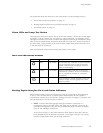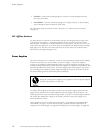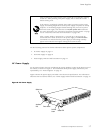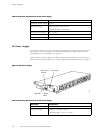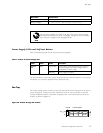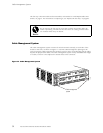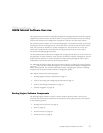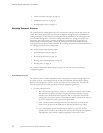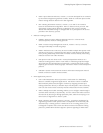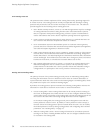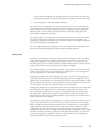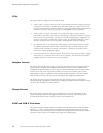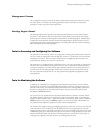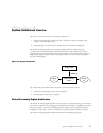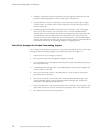Routing Engine So
ftware Components
• OSPF—Open Shortest Path First, version 2, is an IGP developed for IP networks
by the Internet Engineering Task Force (IETF). OSPF is a link-state protocol that
makes routing
decisions based on the SPF algorithm.
• RIP—Routing Information Protocol, version 2, is an IGP for IP networks
based on the Be
llman-Ford algorithm. RIP is a distance-vector protocol. RIP
dynamically routes packets between a subscriber and a service provider
without the subscriber having to configure BGP or to participate in the service
provider’s I
GP discovery process.
• Multicast routing protocols
• DVMRP—Distance Vector Multicast Routing Protocol is a d ense-mode
(flood-and-prune) multicast routing protocol.
• IGMP—Internet Group Management Protocol, versions 1 and 2, is used to
manage membership in m ulticast groups.
• MSDP—Multicast Source Discovery Protocol enables multiple PIM sparse mode
domains to b e joined. A rendezvous poi nt (RP) in a PIM sparse mo de domain
has a peerin
g relationship with an RP in another domain, thereby discovering
multicast sources from other domains.
• PIM sparse m
ode and dense mode—Protocol-Independent Multicast is a
multicast routing protocol used to route traffic to multicast groups that might
span wide-area and interdomain internetworks. In PIM sparse m ode, routers
explicitl
y join and leave multicast groups. PIM dense mode is a f lood-and-prune
protocol.
• SAP/SDP—S
ession Announcement Protocol and Session Description Protocol
handle conference session announcements.
• MPLS appli
cation protocols
• LDP—Label Distribution Protocol provides a mechanism for distributing
labels in n
ontraffic-engineered applications. LDP allows routers to establish
label-switched paths (LSPs) through a network by mapping network-layer
routing information directly to data-link layer switched paths. LSPs created by
LDP can al
so traverse LSPs created by Resource Reservation Protocol (RSVP).
• MPLS—Multiprotocol Label Switching enables you to configure LSPs through a
network e
ither manually or dynamically. You can control how traffic t raverses
the network by directing it through particular paths, rather than relying on an
IGP’s least-cost algorithm to choose a path.
• RSVP—Resource Reservation Protocol, version 1, provides a mechanism for
engineering network traffic patterns that is independent of the shortest path
determi
ned by a routing protocol. RSVP itself is not a routing protocol, but
is designed to operate with current and future unicast and multicast routing
protocols. JUNOS RSVP software supports dynamic signaling for MPLS LSPs.
JUNOS Internet Software Overview
23



